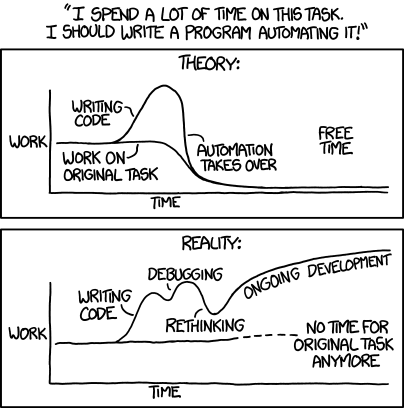
RPA Myths Answered
These are Myths specifically about RPA (Robotic Process Automation) using software robots.
There is no order of importance in this list of 50 myths.
Myth 1 – ChatGPT will replace RPA
Answer – ChatGPT is good at responding to a prompt. RPA is about automating processes. RPA can use ChatGPT as a resource to determine intent or extract data from a document, which RPA can then use to execute an action.
Myth 2 – Automation is costly
Answer – RPA can start from the equivalent cost of a full-time employee on minimum wage (e.g. £2,000 per month). RPA delivers a lot of capacity for processing, the more of the capacity that is used the lower the effective processing cost.
Myth 3 – Automation requires changes to existing systems
Answer – Automation using RPA is able to use the same GUI screens that a person would use to perform the same task. RPA is able to also make use of application API or other technical interfaces where they are available. By using the GUI screens there is no requirement to make any change to the systems that automation is interacting with to perform the task.
Myth 4 – Automation will make most job roles redundant
Answer – Automation is able to perform many tasks. The automation of repetitive tasks will free people’s time so that they can focus on high value work which is more interesting to perform and better utilises human skills.
Myth 5 – Automation and use of Artificial Intelligence are the same thing
Answer – Automation is about changing manual activities and enabling them to be performed without a person being involved, whereas Artificial Intelligence (AI) is a mechanism to be able to leverage existing data to respond to a new question or requirement. Some AI products bundle some automation features to encompass the processing of the AI response into a useful action.
Myth 6 – RPA does NOT deliver employee satisfaction
Answer – When RPA is deployed to process repetitive tasks and release staff from performing the boring work, staff feel a sense of relief. Employees never want RPA switched off as that would mean they have to return to performing the mundane tasks.
Myth 7 – IT Departments don’t like RPA
Answer – IT Departments like the deployment of RPA where it is deployed with appropriate governance, technical support, separation of development, test and production environments. The issue arises when some business departments attempt to deploy RPA as a local automation and do not involve the IT teams or follow IT standards.
Myth 8 – RPA is the same as Digital Transformation
Answer – RPA is about the automation of manual tasks whereas Digital Transformation is where manual activities are implemented as digital processes. Such digital processes may then be automated if the tasks are repetitive.
Myth 9 – RPA is only for back office tasks
Answer – RPA is often used to automate back office tasks as they are typically repetitive and not time synchronised with client interactions. RPA can also be used to automate activity in front office tasks where the operator is directly engaging with the customer and the outcome from the automation is available as part of the dialogue.
Myth 10 – Automating with RPA does not require coding
Answer – RPA can leverage existing templates and some simple automations for personal productivity gains can be
Myth 11 – Automation requires a Centre of Excellence (CoE)
Answer – Automation can be implemented by a small team to meet specific business opportunities. A Centre of Excellence for automation is only required when there is a large programme of automation activities across a business such that are benefits to be gained from coordination and the sharing of knowledge between the automation project teams.
Myth 12 – Processes must be optimised before Automation
Answer – It is often a highly contentious topic when considering automation. If an automation contains in-efficiencies, there is wasted activity within each execution. Such waste is not ideal, the real comparison is that if the waste occurs before automation, it is not made worse by the automation. In fact, the lower cost processing from automation may mean that the effective cost from the waste is also reduced.
Myth 13 – Digital Native organisations do not need RPA Automation
Answer – Businesses that are Digital Native will not have gone through the transition from manual paper based processes, however there can still be manual effort being used to operate the business processes. RPA Automation can be relevant if any of the tasks in the business processes are repetitive. One of the tests for potential automation is that the task is digital input and digital outcome, which in a digital native business is likely to be the case.
Myth 14 – RPA is only useful for Legacy systems
Answer – RPA can work with legacy systems and RPA can also work with modern systems. Some of the newest cloud deliver SaaS functionality can require manual effort to complete tasks which means that RPA could deliver benefits by automating the activity.
Myth 15 – RPA Automation cannot work with Citrix or VMWare
Answer – Although some RPA products may not be able to work with Citrix or VMWare systems, the leading RPA tools such as UiPath can automate solutions that are accessed as Citrix or VMWare technologies.
Myth 16 – RPA Automation cannot work on Mac
Answer – Many RPA tools have been developed for the Windows operating system, but some products like UiPath provide RPA functionality for Mac systems.
Myth 17 – RPA Automation cannot work on Linux
Answer – Many RPA tools have been developed for the Windows operating system, but some products like UiPath provide RPA functionality for Linux systems.
Myth 18 – Mid-Market businesses are too small for Automation
Answer – RPA Automation has emerged as a technology that solved the challenges of large global enterprises. As the RPA products have matured, they have become robust and cheap enough to implement across mid-market business as well as SME organisations.
Myth 19 – Small businesses would not benefit from Automation
Answer – RPA Automation has emerged as a technology that solved the challenges of large global enterprises. As the RPA products have matured, they have become robust and cheap enough to implement across SME organisations. The ROI of the implementation usually depends on the volume of activity to be automated, so it is true that bigger organisations have large volumes and therefore the automation ROI is more attractive.
Myth 20 – Automation with RPA solutions are fragile
Answer – RPA automations are as robust as any other IT system. The different is that RPA implementations often involve interfacing with a number of different applications / systems. A change in any one of these can cause an impact on the RPA.
Myth 21 – Learn RPA and you will get a highly paid job
Answer – When RPA solutions first gained traction with large enterprise customers there was a shortage of skilled staff available which caused peak in remuneration. As the market has matured, the products have become easier to learn and there is a large pool of skilled practitioners. This has resulted in salary levels for RPA skills returning to mid market levels.
Myth 22 – Automation with RPA never fails
Answer – Although RPA automations are robust and the automations can be constructed with some flexibility, they can fail when there are changes in the systems that the automations interact with during processing. This potential for disruption needs to be built into the implementation and appropriate support activities put in place.
Myth 23 – Automation with RPA uses physical robots
Answer – RPA automation is a solution that uses software robots, that are program code. There are no physical robots or components required for an automation.
Myth 24 – Automation is all hype and no delivery
Answer – There has been a lot of media hype about automation taking people’s jobs and there have been some hire profile automation project failures. The reality is that automation can be very effectively deployed and delivers a lot benefits for appropriate tasks. Many businesses have RPA automation deployments that have been operating for years and delivering benefits to the organisations every single day.
Myth 25 – Automation requires high volumes to be useful
Answer – Automation can only be used effectively where there is a repetitive process. It is true that a high volume will deliver a good ROI from automation, however even modest volumes can create a positive ROI. There can be scenarios which it is not just the volume which delivers the value, the ability of an automation to be executed at end time work is available and not wait for a person to be available can be a significant benefit. There can also be significant benefit from an automation completing a task with 100% accuracy and generating audit trail / log information consistently to achieve compliance levels that manual operations can struggle to match.
Myth 26 – Artificial Intelligence (AI) will replace the need for RPA
Answer – Many AI products bundle some AI processing capability with some automation aspects, this is necessary as the manual effort to use AI could otherwise degrade the benefits offered by AI. There are many automation requirements that do not require the use of AI to deliver a solution. RPA delivers automation and can utilise Ai functionality when it is required, this means that RPA is likely to remain a separate section of the market although there will be an overlap with parts of the AI sector.
Myth 27 – RPA just creates Technical Debt
Answer – Technical Debt usually refers to situations where a solution is implemented but it is not viewed as strategic and is expected to be replaced at some point in the future. RPA implementations deal with the technologies that are currently available and address gaps between systems or implement processing for features that do not exist. All applications evolve and some RPA implementations may no longer be required due to new functionality in the future. The rapid ROI achieved with RPA implementations means that there are business benefits to be gained even if the evolution of systems overtime remove the need for some RPA implementations.
Myth 28 – Solutions should use APIs and not RPA tools
Answer – Although RPA technology was developed to work with GUI screens, most modern products like UiPath can equally work with application APIs by leveraging standard protocols.
Myth 29 – Macros can do the same thing as RPA Automation
Answer – Macros are great script code that can be used to be automate activity. Macros are limited to the technology that they interact with and therefore the systems that can be used with macros tend to be limited. RPA provides the same functionality as can be achieved with macros but the processing works across applications and is capable of working across sessions on a machine. It is generally more difficult to create sophisticated macros than it is to achieve the same functionality with RPA tools as they have been designed to be more developer friendly.
Myth 30 – Automation with RPA is just a “Sticking plaster” solution
Answer – RPA can be implemented quickly and deal with short term issues. The rapid ROI does enable RPA to achieve solutions that are only expected to have a short term life, but RPA can also be used to deliver robust automations that are required to enhance strategic applications where the deployments will remain operating for years.
Myth 31 – An average business user can build an RPA solution
Answer – RPA tools have evolved to provide a lot of functionality which be used by a sophisticated business user who has little programming knowledge. Typically, such solutions are in the area of personal task automation. Where RPA solutions are developed for core business processes, they may involve complex logic, the use of application APIs, database SQL, etc. such sophistication requires the knowledge and experience of programmer / developer.
Myth 32 – Business departments can implement RPA without involving the IT Department
Answer – There have been many examples where business departments have identified the need for automation and engaged RPA providers to build a solution. There is a need for IT departments to be involved in any RPA deployment to ensure that it follows appropriate corporate security rules, has the right level of operational governance and the necessary support capability in place to deal with software patches, software upgrades and any fixes arising from external changes.
Myth 33 – Automation is only about productivity gain
Answer – Automation delivers productivity gains, but it can also deliver other benefits. The reduction in human errors once automation is in place generally delivers a significant benefit to a business, with consistency of processing often delivering real compliance advantages.
Myth 34 – Co-workers will not envy those benefiting from task automation
Answer – Once an automation is deployed that releases some staff from the requirement to perform mundane tasks repetitively. Other staff are likely to also want the repetitive tasks that they perform to be automated as almost nobody enjoys performing such work.
Myth 35 – Microsoft PowerAutomate is free
Answer – Microsoft provides some usage of Power Automate effectively for free as it is bundled into the core Microsoft licences. For any business making significant use of Microsoft Power Automate there will be licence fees to pay which are likely to be competitive with the fees associated with other RPA tools.
Myth 36 – RPA is not for SME businesses
Answer – RPA is very relevant to SME businesses as can enable a business to scale without recruiting more staff and is cost effective with a relatively low number of transactions.
Myth 37 – RPA is not for Logistics and Supply Chain businesses
Answer – RPA can deliver a lot of benefits to Logistics and Supply Chain businesses in all of the generic areas in Finance, HR, etc. but also in the handling of information across customer portals and supplier portals if full EDI has not covered every transaction. RPA can assist with the manual activity on Transport and Warehouse systems.
Myth 38 – RPA is not for Manufacturing businesses
Answer – Although physical automation is used on the factory lines, RPA can be very effective in office environment. It can be used in the generic functions of Finance, HR, etc. and it can also be used to automate the use of ERP activity.
Myth 39 – RPA is not for Service businesses
Answer – RPA can deliver a lot of benefits to Service businesses where the emphasis is on the optimal use of people. RPA delivers in all of the generic areas in Finance, HR, etc. but can also automate the admin tasks that are the core of efficient service businesses particularly where Business Process Outsourcing could be involved.
Myth 40 – RPA is not for Accounting businesses
Answer – RPA can deliver a lot of benefits to Accounting businesses, although it is likely that the traditional areas of extracting data from invoices and receipts are covered as well as basic book keeping will already be in place. RPA can assist with the reconciliation checking, the compliance tasks of checking information and filing information, the handling of journals, etc. Not forgetting the generic areas in Finance, HR, etc. for the accounting business itself.
Myth 41 – RPA is not for Legal sector businesses
Answer – Legal activity might be dominated by Words and Contracts, but the activity is delivered using large amounts of admin. RPA is perfect or automating the admin activities, ensuring compliance tasks are performed. RPA assists Legal firms to achieve optimal billable hours for key staff y completing the supporting tasks.
Myth 42 – RPA is not for Hotels and Events businesses
Answer – Hotel and Event businesses need effective staff and supply systems to deliver the services expected by the customers. RPA delivers the admin activities at scale so that day to day work gets completed but peaks can also be achieved when required. RPA’s consistency delivers the compliance requirements so that staff and temporary hires can be supported effectively.
Myth 43 – RPA is not for Construction businesses
Answer – Construction is a physical operation but to achieve success it requires admin processes to engage the right people, with the right resources at the right time. RPA delivers the automation to utilise the core systems so that compliance is achieved and resources are available as required. RPA can also deliver in all of the generic areas in Finance, HR, etc.
Myth 44 – RPA is expensive and needs a big investment
Answer – RPA delivers a good ROI, so the costs are recovered. As the RPA market has matured there are range of cost options available to suit the budgets of any business. RPA does not have to be expensive, Ether Solutions offer a service starting at £2,000 per month.
Myth 45 – RPA is only for simple tasks
Answer – RPA can apply logic and utilise AI where required to automate complex tasks. The consistency that RPA provides often enhances the results when complex tasks are automated as people do not always complete all elements in complex tasks.
Myth 46 – RPA will replace jobs
Answer – RPA can replace the manual activities required to perform tasks. This frees people to focus on exceptions, the unusual and other higher value tasks. It is not so much that RPA will replace jobs, but people who are using RPA will replace businesses who have people who are not using RPA.
Myth 47 – RPA is not secure
Answer – RPA can be more secure that people. RPA robot can make use of Password managers just like people and they can cope with long passwords as well as deal with frequently changing passwords. RPA implementations can be designed with segregation of duties so that secure objectives can be achieved. RPA robots can be implemented to use 2FA and be restricted in terms of servers used to perform the work.
Myth 48 – RPA does not deliver significant business value
Answer – RPA delivers good ROI figures where automation of tasks is appropriate. The automation of manual work has financial value for a business, and it also creates the potential for people to have an improvement in the quality of work they undertake.
With automation in place, the potential to re-arrange work so that activities are performed at different times of day can create a radical change for a business with a corresponding impact on business value.
Myth 49 – RPA can only automate rule based tasks
Answer – RPA can apply logic when executing a task and therefore apply rules. RPA can also make use of the AI functionality to achieve activities such as “Document Understand” and “Email Intent”. Most business processes completed by people can be achieved through a combination of such features. Given the need to train people to perform the business process there is always some scope boundary for any task and providing the “Knowledge” to is available in digital format, most digital tasks can be automated.
Myth 50 – BPO (Business Process Outsourcing) is threaten by RPA
Answer – RPA is being widely adopted by BPO organisations as they have the scale of operations to take advantage of the automations. ROI is important for the BPO to continuously improve. The consistency and audit trail capabilities enable a BPO to enhance its Service Levels. The only threat to a BPO organisation is from another BPO organisation that is already benefiting from RPA.
General
The above are all myths and they are often stated in the media where the authors have a limited knowledge of the subject or have a specific agenda.
If you would like an explanation of why any of the above myths are not true, please contact us to discuss the details.














